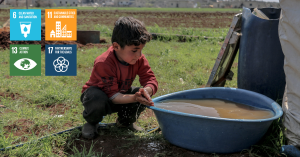Global Mapping Software Discovers New Water Sources in High Water Risk Areas

Working towards water stewardship targets is critical for companies. It is estimated to cost approximately US$114 billion a year between now and 2030 to achieve the United Nation’s SDG 6.
Newly built global water mapping software will assist corporates in identifying high water risk areas and help achieve accurate ESG reporting.
LONDON, UNITED KINGDOM, November 15, 2022 /EINPresswire.com/ -- The World Economic Forum has released new case studies that demonstrate how comprehensive environmental, social, and corporate governance (ESG) reporting has begun to drive corporate transformation around the world, notably in sustainability initiatives and company culture.The case studies show that, despite some progress, organisations around the world are still battling with conflicting and different ESG frameworks. 69% of listed equities, reporting via CDP (formally known as the Carbon Disclosure Project), state that they are exposed to water risks that could generate a substantive change in their business. The potential value at risk is predicted to be more than US$225 billion.
The United Nations predicts a 40% global shortfall in water supply by 2030 if current consumption and production patterns do not change. As a result, over 200 global companies have joined the Water Resilience Coalition and CEO Water Mandate1 to achieve measurable net water positive impacts in water-stressed basins. These companies seek to support Sustainable Development Goal2 (SDG) 6 (Clean Water & Sanitation) reputable and trusted programs. Manufacturers are also seeking alternative sources of water for production and ingredients as well as the use of new technologies to reduce reliance on groundwater, especially in high water risk areas.
Looking to assist corporates in this endeavour, a newly developed interactive global mapping software, Sustainable Water Impact Maps (SWIM) created by Australian start-up Botanical Water Technologies3 (BWT) provides the flexibility and simplicity for corporates to explore and analyse global water basins with various overlay mapping tools to identify new water sources to assist with water stewardship and ESG reporting.
SWIM comes as an added feature to BWT’s water trading platform the Botanical Water Exchange (BWX) which offers channels for the sale and delivery of water for ingredient purposes or for sale as Water Impact Credits (WICs) which fund accredited community and environmental impact projects. “Our goal for BWX was to take the friction out of a complex process. By adding SWIM to our platform, it will no doubt offer corporates increased visibility and transparency to assist them in meeting their water stewardship targets” said Terry Paule, Co-Founder and CEO at BWT.
As the International Food Policy Research Institute (IFPRI) suggested, the current business-as-usual water management practices and levels of water productivity will put at risk US$6.3 trillion, or 45%, of the projected 2050 global GDP, equivalent to 1.5 times the size of today’s entire global economy. With growing populations and increasing economic activity in many regions, the demand for water continues to increase. It has now become absolutely necessary that a globally harmonised measurement system be formed, and the relevant tools be accessible to ensure that corporates can efficiently work towards achieving their ESG goals.
The SWIM platform looks to support corporates by providing transparency and customisation to an intricate process. “SWIM was built using Agtuary's Know Your Environment (KYE) services. SWIM enables organisations to map resilience, measure value, monitor output and report on sustainability & climate risks globally. Powered by satellite imagery, climate data and AI, SWIM automates and enhances reporting related to agriculture, climate, and nature. SWIM will support ESG reporting to ensure a sustainable future of our planet's water and environment” said Matthew Rozek, CTO at Agtuary.
SWIM provides a complete picture of water basins, water usage, practices, climatic conditions, and physical processing locations to assist corporates in identifying risks and leveraging opportunities. Organisations using SWIM will be able to map their own physical locations and have a sound understanding of areas impacted by water scarcity and thus will have the ability to monitor, report on and make critical decisions related to the planning and management of their water targets.
With regulators beginning to implement mandatory ESG reporting across regions, coordination will be critical to ensure that the clarity and transparency of ESG reporting improves globally.
If you would like to learn more and help leave the world a better place, visit www.wegrowwater.com
Botanical Water Technologies PR Team
Botanical Water Technologies
email us here
1 https://ceowatermandate.org/
2 http://sdgs.un.org/goals
3 https://www.wegrowwater.com


